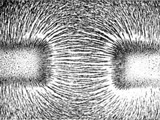|
|
TODAY.AZ / Weird / Interesting
Magnetic microprocessors could enable the most efficient computers physically possible
08 July 2011 [12:12] - TODAY.AZ
 Electron-free magnetic microprocessors would use 1 million times less energy per flop than today’s computers, according to researchers at the University of California-Berkeley. They would be so efficient, they would consume the least amount of energy allowed by the second law of thermodynamics.
Electron-free magnetic microprocessors would use 1 million times less energy per flop than today’s computers, according to researchers at the University of California-Berkeley. They would be so efficient, they would consume the least amount of energy allowed by the second law of thermodynamics.For now, computers run on electricity, which means electrons moving around and generating waste heat. But a magnetic microprocessor would not need any electrons. Instead, it would use the polarity of nanoscale bar magnets to represent the 0 and 1 of binary memory. If the nanomagnets are packed close together, their poles will interact, serving as transistors and thereby allowing simple logic operations.
Jeffrey Bokor, UC Berkeley professor of electrical engineering and computer sciences, and grad student Brian Lambson are trying to develop these magnetic computers. Their goal is a computer that operates at the Landauer limit, which at room temperature equates to a loss of 18 millielectron volts of energy per operation. This is the minimum energy that a single logic operation, like AND or OR, would dissipate. A physicist named Rolf Landauer computed this limit 50 years ago.
That number, 18 thousandths of an electron volt, is the merest whiff of energy — for comparison, it is about half the thermal energy of atoms at room temperature. The Large Hadron Collider collides particles at a maximum of 7 trillion electron volts, which is equal to the energy you'd get from eating 0.00013 micrograms of a candy bar.
A computer that uses such infinitesimal power would be a major advancement, Bokor said in a Berkeley news release. If it the computer could work at colder temperatures, it would be even more efficient (the Landauer limit is proportional to temperature).
“Even if we could get within one order of magnitude, a factor of 10, of the Landauer limit, it would represent a huge reduction in energy consumption for electronics,” he said. “It would be absolutely revolutionary.”
Lambson and Bokor wanted to test the energy efficiency of a simple magnetic logic circuit and magnetic memory, so they conducted calculations and computer simulations. They found a simple memory operation, such as erasing a magnetic bit, “can be conducted with an energy dissipation very close, if not identical to, the Landauer limit,” the news release says.
Current tests of these systems still require an electrical current to generate a magnetic field, which flips or erases a nanomagnet’s polarity. But Bokor and colleagues hope that new materials, such as multiferroic alloys, could make the electrical currents unnecessary. A new era of magnetonics, instead of electronics, could be in our future.
/Popular Science/
URL: http://www.today.az/news/interesting/89967.html
 Print version
Print version
Views: 2356
Connect with us. Get latest news and updates.
See Also
- 05 February 2025 [19:41]
Japan plans to negotiate with Trump to increase LNG imports from United States - 23 January 2025 [23:20]
Dubai once again named cleanest city in the world - 06 December 2024 [22:20]
Are scented candles harmful to health? - 23 November 2024 [14:11]
Magnitude 4.5 earthquake hits Azerbaijan's Lachin - 20 November 2024 [23:30]
Launch vehicle with prototype of Starship made its sixth test flight - 27 October 2024 [09:00]
Fuel prices expected to rise in Sweden - 24 October 2024 [19:14]
Turkiye strikes terror targets in Iraq and Syria - 23 October 2024 [23:46]
Kazakhstan supplied almost entire volume of oil planned for 2024 to Germany in 9 months - 23 October 2024 [22:17]
Taiwan reported passage of Chinese Navy aircraft carrier near island - 23 October 2024 [21:50]
Russia remains largest oil supplier to India
Most Popular
 Mono-Armenia what tales did Pashinyan tell in Washington
Mono-Armenia what tales did Pashinyan tell in Washington
 Pashinyan signed up for a ChatGPT course
Pashinyan signed up for a ChatGPT course
 Turkiye’s President Erdo?an approves migration cooperation agreement with Azerbaijan
Turkiye’s President Erdo?an approves migration cooperation agreement with Azerbaijan
 Azerbaijan’s fire safety service reviews 2024 successes and prepares for 2025
Azerbaijan’s fire safety service reviews 2024 successes and prepares for 2025
 Azerbaijan bans entry of Russian MP over offensive remarks
Azerbaijan bans entry of Russian MP over offensive remarks
 Chamber and Organ Music Hall to hold series of concerts
Chamber and Organ Music Hall to hold series of concerts
 February proves unsuitability of Pashinyan's project
February proves unsuitability of Pashinyan's project
